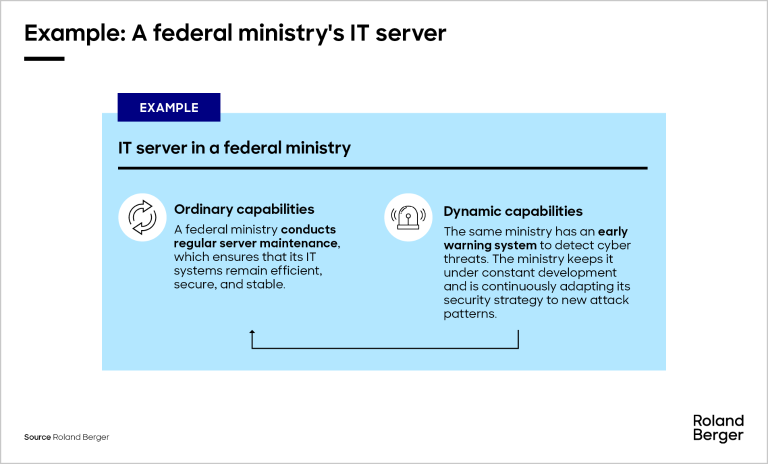Merging separate public organizations requires careful planning and execution to avoid wasted opportunities or value destruction in today's changing world.


How dynamic capabilities can support government modernization
Uncertainty and rapid change call for transformation within public administration
Public administrations are increasingly confronted with rapid changes and uncertainty. Global pandemics like Covid-19, geopolitical crises, and digital transformation are examples in a long line of challenges. Administrations must therefore be proactive, taking forward-looking actions that address both current and future requirements and safeguard the effectiveness of the state long term.

The new challenges add fresh impetus to the debate around the need to modernize public administration. Germany's government organizations are seen as too static, too slow, too undigitized. This has been a subject of discussion for a very long time, even more so around the 2025 federal elections. Something must be done now, and not just in certain areas but across the board, from the ground up.
Basic administrative processes and tasks need to be executed in an efficient and secure manner. The country's citizens rightly expect clearly defined and standardized processes to be carried out reliably, quickly, and accurately. Besides ensuring that day-to-day administration runs smoothly, the government organizations that deal with it are also being called upon to enable new forms of innovation and dynamism. The goal, on the one hand, is for them to facilitate incremental improvements to existing processes (for example, speeding up the process of tax collection and tax administration with end-to-end digital processes). And at the same time, they are expected to be innovative and dynamic – enabling disruptive changes – and to make their administration fit for the future.
"Acting with foresight is fundamental to ensuring the long-term performance of the state. The dynamic capabilities approach can provide important impetus for this. "
New, cross-organizational collaboration is one example of this. The collection and administration of taxes, for instance, could be revolutionized through the use of a tax administration platform that connects the different participants such as companies, banks, and tax advisors and allows information to be shared in real time according to the once-only principle. But how can public administrations integrate such forms of innovation and dynamism into their existing system?
Dynamic capabilities: A solution for more agility
In the classic management literature, dynamic capabilities are a highly regarded approach. They allow businesses to change and innovate continuously. These changes can be both reactive (adapting to changes in the market) and proactive (creating new markets). Dynamic capabilities give companies a sustainable competitive advantage in a rapidly and constantly changing market environment. Yet the basic assumptions of the approach are not restricted to private-sector organizations. Dynamic capabilities also provide interesting starting points for the challenges facing public administration. It is therefore worth taking a closer look at the approach in the context of the current modernization debate.
Academics David J. Teece, Gary Pisano, and Amy Shuen were the first to describe the approach in detail in their 1997 publication "Dynamic Capabilities and Strategic Management". Dynamic capabilities are now referred to in the literature as the "holy grail" of sustainable competitive advantage. Basically, there are two types of organizational (collective) capabilities:
- Ordinary capabilities refer to existing tasks and processes that a public administration must perform in order to fulfill its basic functions. As a rule, these are efficient and well-established processes.
- Dynamic capabilities, on the other hand, contribute to the (proactive) adaptability of organizations by integrating, building, and reconfiguring internal and external competences. This can happen internally through cross-functional teams or through cross-organizational co-creation or the early involvement of service recipients. One example is the targeted integration of citizens or companies in the testing of new solutions. The approach is based on the interplay of skills, routines, methods, structures, and decision-making rules within an organization. In most cases, the literature speaks of collectively learned capacities (in the sense of capabilities) within an organization that are not easily transferable.
Both types of capabilities are important for the future – operational task fulfillment as well as dynamic evolution and adaptation. It goes without saying that the IT systems of a federal ministry or a local authority must be stable and secure in day-to-day operations. But they must also be able to defend themselves against the latest cyber threats and anticipate new and emerging threats in order to guarantee the security of people's data – both today and tomorrow. To this end, they need to regularly readjust their early warning system. Constant realignment demands bold, experimental, and, where necessary, scenario-based approaches.
As (technology) development cycles grow ever shorter, dynamic capabilities become increasingly important. They fall into three categories: sensing, seizing, and transforming.
Sensing refers to capabilities that enable you to observe and recognize (relevant) changes in your organization's environment. Rita McGrath, a Columbia University professor, describes in her book "Seeing Around Corners" how snow melts first around the edges. This means signs of change often appear (first) at the edges – in other words, not in any centralized location. So it is important to keep a closer eye on those edges. State-of-the-art early warning systems are an example of dynamic capabilities in the sensing context. As well as identifying changes, it is also important to identify opportunities that could arise from the change.
Seizing is about capabilities that allow you to understand and substantiate which of the opportunities represent relevant changes and to prioritize them within your organization, which you can do by making the right resources available. It also involves exploring strategic options and managing them.
Transforming concerns capabilities that are necessary to actually redesignate structures, processes, and resources. This is about realigning the organization so that it can respond to the opportunities you have identified and verified. Having a future mindset within the organization is key here.
Working out the status quo in your organization
Your answers to the questions below (among others) will give you a first idea of where your organization stands in terms of dynamic capabilities:
Sensing:
- How do we identify new trends that are relevant to society and our organization?
- Are our people encouraged or incentivized to discover changes within their work environment, even if it is not their original task?
- Do we work across organizations to spot trends?
- Once we have picked up on changes, do we work within a structured process (such as further interpreting the change, hypothesizing) to test them?
Seizing:
- How do we use resources (financial, human, etc.) for the opportunities we've identified?
- Are we able to quickly substantiate innovations on the basis of hypotheses? Do we have intellectual or real spaces in which to experiment?
- How fast are we at integrating identified trends or the need for change into existing processes? How long are our current implementation times?
- Are we prepared for different scenarios around key issues?
- Do we have backup solutions or a portfolio of options for dealing with the scenarios?
- How much of our work takes place across disciplines and across functions?
Transforming:
- How do we communicate changes?
- Can we get small, effective teams with sufficient autonomy up and running quickly?
- Do our people have the right training?
- #FutureMindset: Do we have a future mindset, and do we have the structures to allow us to learn fast from our mistakes, go digital, and role-model modern leadership? How strong is our hedging mentality and our risk aversion?
- Are responsibilities clearly defined?
How successful modernization ultimately is in the public administration sphere increasingly depends on the level of agility. The dynamic capabilities approach can offer significant impetus in that respect. What public administrations need to do now is build and expand the (right) dynamic capabilities and have the ability to use them in a structured manner. Only then will they be able to meet the rapidly changing demands and challenges they face and thus be, and remain, capable of operating as they should. Doing so also provides public administrations with a basis for being able to serve society effectively and efficiently in the future (safeguarding their effectiveness).
Developing dynamic capabilities is a complex process that needs to be assessed on an individual basis. Our test questions give you a first idea of where you stand by creating a greater awareness of the important aspects of dynamic capabilities. And they allow you to make an initial assessment of your organization.
Want to learn more about dynamic capabilities in public administration? Let's talk – we look forward to discussing it with you.
We would like to thank Luca J. Scheuer for his contribution to this article.







